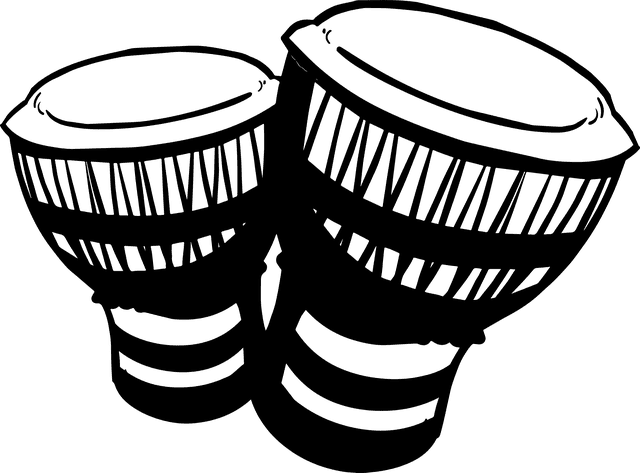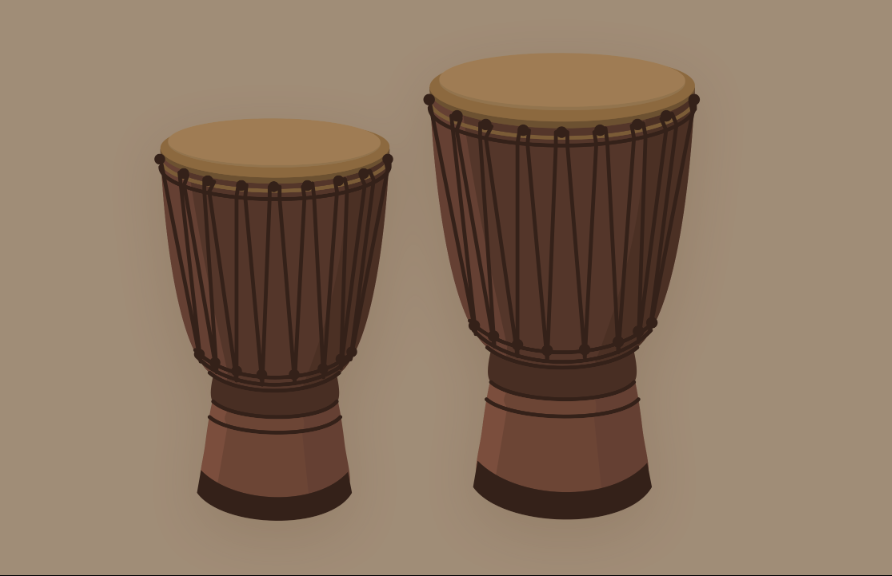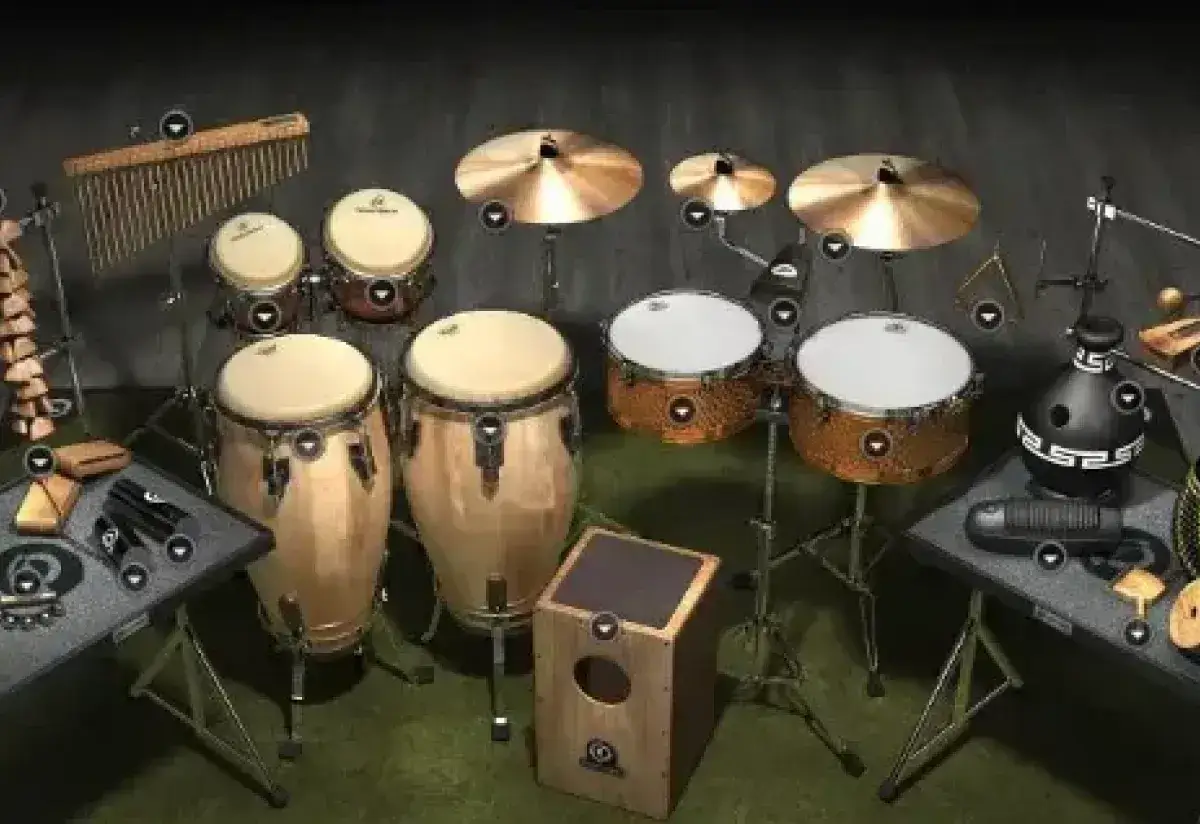Overview Of Djembe
The Djembe drum, also spelled Jembe, is a popular goblet-shaped membranophone originating in West Africa. The name ‘Djembe’ means to ‘Gather together in peace’ in the Bambara language. The drum has a wide head covered by a skin with a narrow base that’s open at the bottom. This unique shape makes the Djembe one of the loudest hand drums. Although the drums vary somewhat in size, they are typically around 35 cm in diameter, 60 cm tall, and 9 kg in weight.
Traditional Djembes are carved from a single piece of hardwood with a drumhead covered by untreated rawhide. While many different materials are used, highly valued Djembes are carved from the Lenke tree and covered with goatskin. Those drums are revered for their spiritual meaning. The drum shell is traditionally carved by hand and the inside of the drum is left rough. The texture of the inside of the drum gives each one a unique sound.
The Djembe skin is held in place with two or three large rings secured by rope. The ropes are tied around the wide top portion of the drum in a vertical pattern. These ropes are also used to tune the drum, which is discussed in the ‘Mechanics’ section below. The base of the drum called the foot, may have carvings, rope wrapped around it, shells, or metalwork attached. These additions don’t alter sound quality; they are decorative only.
Traditional Djembe music consists of a drum ensemble made up of mostly djembe players, known as Djembefolas, with other African hand drums as accompaniment, such as the dunun or Khassonka. Each part of the ensemble plays a different repeating rhythmic pattern, called a cycle, at differing pitches. These patterns may be made up of any number of beats but Djembe rhythms for beginners are typically shorter, consisting of four beats per phrase. These complex rhythm patterns form polyrhythms, the melody of Djembe music. Typically, the Djembe with the highest pitch in the ensemble plays solo phrases during a performance.
History Of Djembe Drum

The Djembe drum originated in West Africa during the 1200s CE. It’s possible that the drum had predecessors, or was invented even earlier, but there is no written record. It is believed that the instrument was invented and distributed by the blacksmith caste known as Numu in the modern-day regions of Guinea, Mali, Ivory Coast, and Senegal.
Additionally, there are many creation myths and stories surrounding the Djembe. One of the most well-known beliefs is that the Djembe drum contains three spirits: that of the tree it was made from, that of the animal whose skin is played, and that of the person who carved and made the drum.
The Djembe became a cornerstone of West African drumming during the following centuries, gaining popularity in many different regions and traditions in Africa. During this time, the Djembe was played only by men, along with other drums featured in performances. Women usually played percussion instruments like the shekere and kese kese. This tradition wouldn’t be challenged until much later.
During the 1950s, the instrument gained worldwide attention with the foundation of Les Ballets Africains, Guinea’s first national ballet. The ballet featured rhythms and dances from many different spiritual traditions and toured widely across Europe. During the remainder of the 20th century, many African countries founded national ballets featuring Djembe music, which led to greater awareness and teaching appearances all over the world.
In the 1990s, the first female Djembefolas were included in ballet performances. These musicians were so well received that an all-female ballet group was formed, called Nimbaya. Currently, there are many world-renowned female Djembefolas, including international drum competition winners.
During the same period, Djembes made outside of West Africa started being distributed for the first time. Manufacturers in Asia, Germany, and the US have produced many variations of the traditional drum. Today, both traditional and Westernized Djembe drums are used in a large number of musical genres all over the world, including international folk music, Latin percussion, and jazz.
Types of Djembes
Djembes vary between drum makers. Unlike string instruments, which must be exact to produce similar sounds, hand drums have more room for individuality. Traditional Djembes are still hand-carved in West Africa by families who have been making them for generations. Drum makers in Mali, Guinea, Senegal, and Burkina Faso create Djembes from traditional wood with traditional tools and techniques. Manufacturers outside of West Africa have begun selling variations on the original drum in the last few decades.
Many of the reproduction instruments are made of softer woods, such as mahogany or Tweneboa, and have a different tone than a traditional Djembe. Western percussion manufacturers have also produced djembes with fiberglass bodies and synthetic skins that are tuned with lugs and a key like many Western drums. Drummers can learn to play djembe drumming patterns on these instruments but the sound will be different.
Playing Techniques

When learning how to play the Djembe, it’s best to start with the basics before learning individual rhythm patterns. Learning to play the Djembe drum takes as much practice and dedication as any instrument and it has its distinct playing techniques and traditions. First, because the bottom of the drum is open, it shouldn’t sit flat on a surface. While seated, the Djembe should rest between the knees while tilted away from the floor.
These are some of the basic notes to learn as a beginner:
Bass: Strike the center of the drum head with a flat palm and fingers held together. Pull the hand away immediately after it strikes, allowing the sound to reverberate. This is the most common note and it forms the base of most djembe rhythm patterns.
Tone: Strike the rim of the drum with slightly curved fingers that are held together in a cup shape. The fingers should hit the edge of the drum at the same time as the knuckle meeting the rim. Like the bass note, the tone note requires players to pull their hands away immediately after striking the drum.
Slap: While cupping the hand with fingers together, strike the drum head between the center and the edge with the side of the hand. This note should be a rapid hand movement.
Ping: With the fingers held together, strike the edge of the drum head with the fingertips, pulling up immediately. The first joint of the fingers should be at the edge of the drum, even if that means only some fingertips touch the drum head.
Muffled tone: This note is just like the tone note above except the hand is held to the drum head after striking it. This mutes and prolongs the tone.
Mechanics

Djembe drum heads are mounted to the shell using a rope. Modern drums only use rope made of synthetic materials because they are low-stretch and less likely to fray. Typical ropes are made from kern mantle and polyester. Higher-quality materials can create ropes that are nearly impossible to stretch but they come at a higher price.
Vertical ropes hold the skin to the drum head with rings and are tightened into place. At this stage, the drum is at its lowest pitch. To achieve a higher pitch, which is especially important for a soloist, the ropes are twisted to form diamond shapes. Called Mali weave, this technique keeps tightening the skin which increases tension. This unique method of tuning allows the Djembe to have an incredible range of pitch for a relatively small drum.
Notable Djembe Players
There are many talented Djembefolas, both traditional and contemporary. Below are some of the most well-known Djembe players from around the world today.
- Adama Drame
- Amara Kante
- Anne-Yolaine Diarra
- Ashok Kumar
- Bolokada Conde
- Kassoum Diarra
- Laurent Camara
- Mamady Keïta
- Manumou Camara
- Melissa Hie
- Monette Marino-Keita
- Rainer Polak
- Salimata Diabaté
- Sanga of The Valley
- Seny Toure
- Taufiq Qureshi
- Varun Venkit
- Zoumana Dembele










